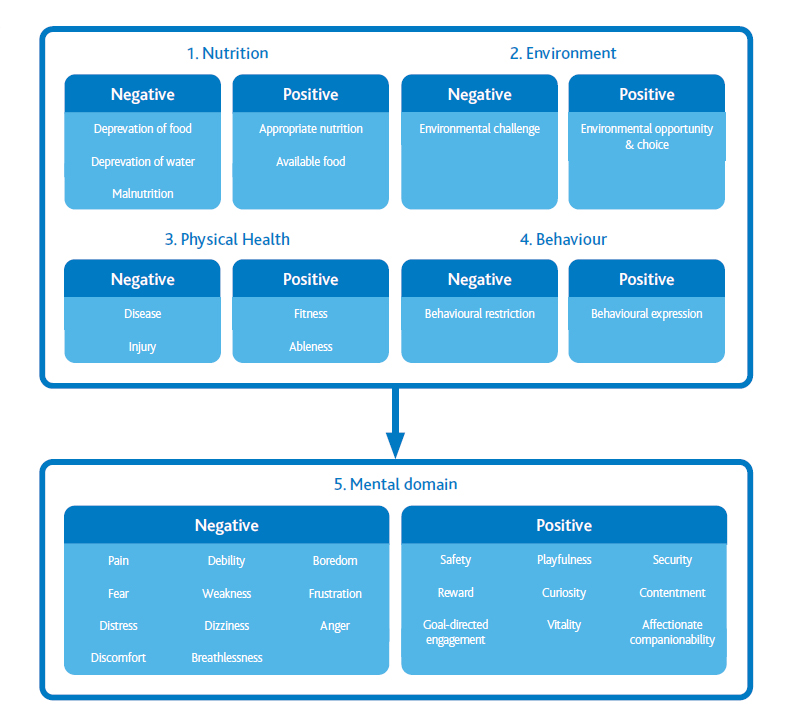
Please note: Our website no longer fully supports IE11, as such you may encounter issues using our website, please try an alternative browser such as Google Chrome, Mozilla Firefox, Microsoft Edge (Windows) or Safari (Mac).

Please note: Our website no longer fully supports IE11, as such you may encounter issues using our website, please try an alternative browser such as Google Chrome, Mozilla Firefox, Microsoft Edge (Windows) or Safari (Mac).
ABTA’s Animal Welfare Guidelines lists activities have been classified as unacceptable, as defined by evidence supplied by experts:
1. Unacceptable practices involving animals in captive attractions
2. Unacceptable practices involving animals in cultural events and activities
3. Unacceptable practices involving free-roaming wild animals
Basic welfare requirements for animals managed and/or dependent upon human beings
Application of and adherence to these basic welfare requirements, as structured within the Five Domains framework (see below), will ensure a basic level of welfare and that is essential in striving to provide animals with a good quality of life. The four physical and functional domains of Nutrition, Environment, Physical Health and Behaviour combine to result in the animal’s Mental State.
Nutrition
1. All animals have unrestricted daily access to adequate and clean drinking water in line with their species-specific needs1.
2. All animals are provided access to food that is adequate in quality, amount and variety for the species, the captive environment and the individual animals’ needs. Feeding routines should be species-specific, mentally stimulating and encourage natural behaviours.
Environment
3. In captivity, enclosures are environmentally complex, including natural substrate, structures, shelter and environmental enrichment, in order to encourage a normal and diverse behavioural repertoire. All animals should be able to access shelter and a climatic environment suitable for their species specific needs and seek privacy from view.
4. In captivity, enclosures are clean, hygienic, free of excessive artificial noise such as visitor or
speaker noise, and well maintained (for example, devoid of excessive faeces, urine or rotting food,
litter, not waterlogged, not infested with vermin etc.)
Physical Health
5. The facility has access to a vet, either employed or externally contracted, who is knowledgeable and experienced in the health and welfare of the relevant animals.
6. There is a policy not to surgically modify the skin, tissues, teeth or bone structure of animals, and not to sedate animals, unless it is for the purpose of genuine medical treatment or improved welfare, and always under the guidance of an appropriately trained vet.
7. Complete, accurate animal stocklists, veterinary records and any appropriate licences or permits should be up-to-date and available for inspection. The required paperwork should be in place for all animals.
Behaviour
8. In captivity, enclosures (including pools) or methods used to contain the animals for temporary
periods, allow all the animals to move and exercise freely, and to maintain sufficient distance
from other animals in case of conflict.
9. Depending on their species-specific and seasonal needs, animals should have the opportunity
to interact regularly with other members of their species. Animals should not be prematurely
separated from their young.
10. Any training of animals should never involve punishment or food deprivation.
1. Working animals should have regular access to clean drinking water while at work and unrestricted access to water when at rest. Example of species-specific need: aquatic animals and some reptiles get their required hydration through their food only.
1. Tethering or hobbling during an animal’s non-working period should be for a limited time only (see species-specific guidance in Section 5 of the Working Animals manual). When tethered, the animals should be able to walk, lie down and stand up without putting tension on the tether, and reach basic resources like food, water and shade. If hobbles are used, they should join the two front legs, the straps should be lined and regularly greased, be adjustable and have a quick-release mechanism. All tethered or hobbled animals require a high degree of supervision.
2. Young, pregnant, nursing, injured, ill, distressed or elderly animals should not be ridden, or be required to carry/pull loads. Equids (for example, horses, mules, donkeys and zebra hoofed mammals) should not be worked before they are three years old; camels should not be ridden before four years. Weaning should not be conducted for horses, donkeys and mules before six months and for camels not before four months. In all cases, it is preferable for weaning to occur naturally.
3. Equipment should fit, be comfortable, not cause distress or injury, and be in working order (for instance, tyres properly inflated on a working cart). It should be
cleaned and dried after use. Equipment should be removed during rest periods and when the animal is eating or drinking.
4. Animals should train and work within their physical capabilities. Loads should be appropriate for the animal’s size and ability, body condition and fitness level (for example, not more than one person on an equine or camel, but equally, a 150kg person should not ride a 150kg donkey), work should not be in the hottest part of the day and animals should have regular rest periods each day of at least an hour between working periods.
5. Effective and regular shelter should be provided for working animals both in resting and working environments to avoid heat or cold stress.

ABTA’s Animal Welfare guidelines (2019 edition) and its supporting guidance manuals build upon the principles of the extended Five Domains Model (developed by Mellor & Beausoleil (2015), originally based on the Farm Animal Welfare Council’s Five Freedoms (FAWC 1979)) and the Welfare Quality® criteria.
